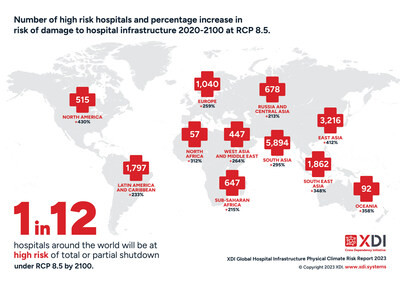LONDON, Dec. 2, 2023 /PRNewswire/ — 1 in 12 hospitals around the world could face partial or total shutdown from climate change extreme weather events if countries fail to curb fossil fuel emissions, according to a new report released today by XDI (Cross Dependency Analysis) – a global leader in physical climate risk analysis.
As a result, communities hit by hurricanes, severe storms, flooding, forest fires and other disasters could be cut off from emergency hospital care right when they need it most, they say.
“Climate change is increasingly impacting the health of people around the world. Our analysis shows that without a rapid phase out of fossil fuels, the risks to global health will be exacerbated further, as thousands of hospitals become unable to deliver services during crises,” said Dr Karl Mallon, Director of Science and Technology, XDI (Cross Dependency Initiative).
The 2023 XDI Global Hospital Infrastructure Physical Climate Risk Report analyses the physical risk to over 200,000 hospitals around the world to six climate change hazards: coastal inundation, riverine flooding, surface water flooding, forest fire, extreme wind and cyclone wind. The analysis focuses on physical damage to building structures, and calculates how different emission scenarios can reduce risk.
As part of the report, XDI is releasing the names, location and level of risk (high, medium, low) for each individual hospital in the analysis (200,216 hospitals). XDI is urging all governments to check for high risk hospitals in their region and conduct further analysis to understand and reduce this risk.
Key findings
- Without a rapid phase out of fossil fuels, up to 1 in 12 hospitals worldwide will be at high risk of total or partial shutdown from extreme weather events by the end of the century – a total of 16,245 hospitals. A residential or commercial building with this level of risk would be considered uninsurable.
- 71% (11,512) of high risk hospitals by 2100 will be in low and middle income countries.
- Limiting global warming to 1.8 degrees celsius with a rapid phase out of fossil fuels would halve the damage risk to hospital infrastructure compared to a high emissions scenario.
- South East Asia has the highest percentage of hospitals at high risk of damage from extreme weather events in the world. With high emissions, almost 1 in 5 hospitals (18.4%) in South East Asia will be at high risk of total or partial shutdown by the end of the century.
- South Asia has the highest number of hospitals at risk.
- Hospitals located on coastlines and near rivers are most at risk.
“Governments have a duty to populations to ensure the ongoing delivery of critical services. We urge all governments and health administrators to review this report and identify high risk hospitals in their jurisdiction so that they can take appropriate action,” said Dr Mallon.
About XDI
The data behind XDI (Cross Dependency Initiative) has been helping global leaders price physical climate risk since 2007, making the group the world’s longest standing independent specialist in physical climate risk and adaptation analytics. XDI is part of The Climate Risk Group.
![]() View original content to download multimedia:https://www.prnewswire.com/news-releases/physical-climate-risk-analysis-of-over-200-000-hospitals-exposes-risk-of-shutdowns-from-extreme-weather-302002698.html
View original content to download multimedia:https://www.prnewswire.com/news-releases/physical-climate-risk-analysis-of-over-200-000-hospitals-exposes-risk-of-shutdowns-from-extreme-weather-302002698.html
SOURCE XDI (Cross Dependency Initiative)

Featured image: Megapixl © Rmarmion




